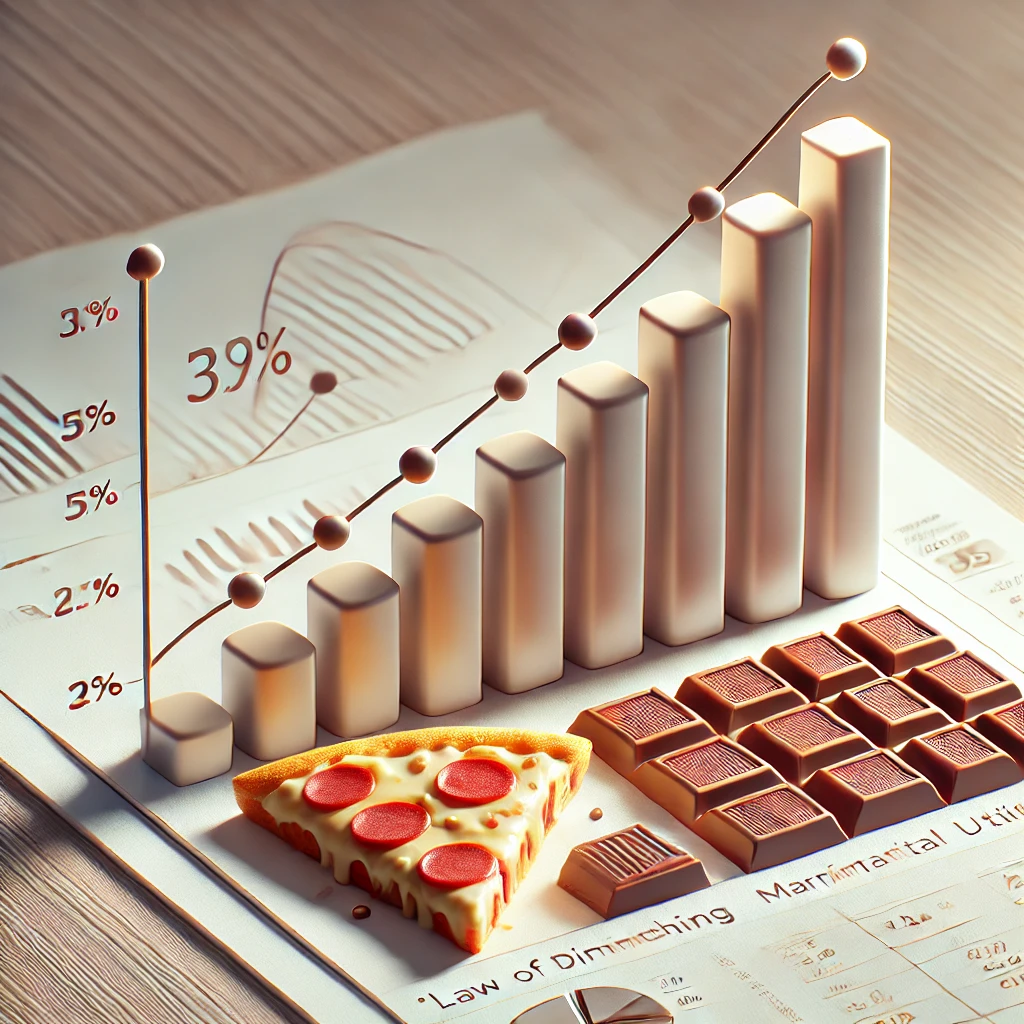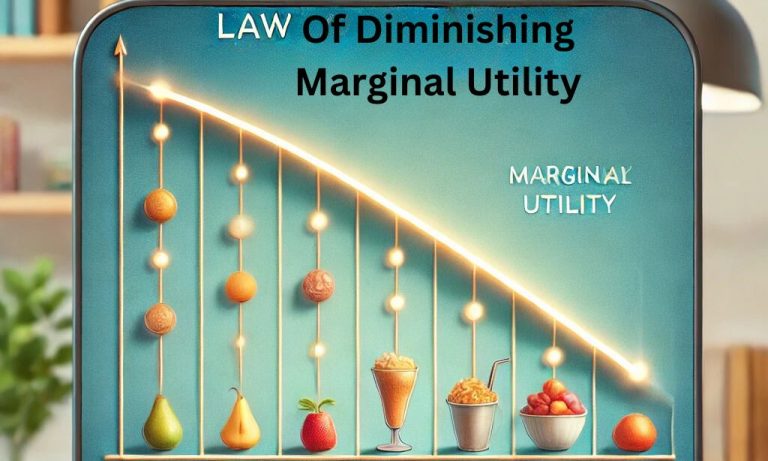The Law of Diminishing Marginal Utility is a concept that lies at the very core of economics, explaining how satisfaction or utility gained from the consumption of additional units of a good or service tends to decrease as more units are consumed. In other words, it shows that the more a person consumes a product, the lesser satisfaction he or she will derive from each additional unit. This law plays a major role in understanding consumer behavior, pricing, and decision-making in economics.
The article will finally highlight the law of diminishing marginal utility in terms of concept, importance, assumptions, and practical application along with exceptions to the law, comparison with total utility, and much more.
Explain the Law of Diminishing Marginal Utility
The Law of Diminishing Marginal Utility illustrates that with each successive unit, the person consumes of a good or service, additional satisfaction derived by each unit will eventually decline. That is, the first slice of pizza might be a heaven of satisfaction, but when the quantity consumed increases to four slices or five slices, satisfaction from another slice starts to diminish.
This is important for the consumer’s decision-making process. The consumers will tend to maximize total utility but the marginal utility, meaning additional satisfaction gained from an extra unit of consumption, will get smaller as one consumes more of the product. In simple words, whereas the first few units of consumption bring substantial pleasure, the marginal increase in the benefit of every subsequent unit decreases progressively.
Importance of Law of Diminishing Marginal Utility
The significance of the Law of Diminishing Marginal Utility is that it can explain a lot of economic phenomena, from consumer behavior to pricing strategies and market demand. The law dictates how people allocate their income, how businesses price their products, and how governments understand consumption patterns. This principle is important not only for economists but also for consumers, producers, and policymakers. Here’s why:
- Consumer Behavior: Law helps in understanding why consumers make choices and how they allocate their limited resources (money) among various goods and services. When the marginal utility of a product falls, consumers are likely to switch to other goods or reduce consumption, ensuring their total utility remains maximized.
- Pricing Mechanism: Businesses and producers can employ this concept to determine how to set optimal pricing policies. According to the law, the value consumers accord to goods decreases with increased levels of consumption. Hence, businesses may offer quantity discounts or special pricing to encourage consumers to buy more.
- Resource Allocation: In this respect, governments consider the application of this principle to public policies on taxation, welfare, and pricing for public goods. Knowing the impact of diminishing marginal utility on consumer choice enables more effective policy decisions on resource allocation and consumption taxes.
- Market Demand: The law of demand contributes to the downward-sloping demand curve in economics. As additional units of a good do not bring as much satisfaction to consumers, they are unwilling to pay high prices for them. This is why, normally, demand decreases with a price rise.
- Well-being and Welfare: It also facilitates the study of economic welfare and social benefits. Once the way marginal utility decreases, governments and corporations can work out policies leading to the maximum welfare of society by stimulating better consumption.
Assumptions of Law of Diminishing Marginal Utility
The assumptions of the Law of Diminishing Marginal Utility have to be known to understand how the law works. Several assumptions make up the base for the law, including the following:
- Rational Consumer Behavior: The law presumes that consumers behave rationally to maximize their total utility. It implies that the individual will go on and on consuming a good or service if the marginal utility of the next unit of consumption is greater than the price of the good or service for its consumption.
- Homogeneous Goods: In this case, the law believes that all units of the good used are identical. For instance, if a person consumes apples, this law assumes that each apple is equivalent in quality and that satisfaction is provided equally. If those apples differ in quality, possibly the law will not be quite the same.
- Constant Consumption Time and Place: The law assumes that the consumption of goods happens under similar circumstances, in terms of time, place, and other factors. If a person consumes a good in one setting and later in another (say, after exercising), the marginal utility could change.
- Utility is Quantifiable: The law further presumes that utility can be quantified, though utility is a non-quantifiable concept. In reality, economists make use of utility as a theoretical construct to explain consumer preference.
- Quality of Goods Does Not Change with Increase in Consumption: The quality of the good does not change as consumption increases. If it does change (for instance, an ice cream melting), the marginal utility would fall much more sharply.
- Short Time Frame: The law applies mainly to short-term consumption. In the long term, tastes and preferences change, which may cause a variation in marginal utility.
Law of Diminishing Marginal Utility Example
One of the best ways of explaining the Law of Diminishing Marginal Utility is to explain it with real-world examples. Let’s take the example of a person who is buying a bottle of water.
Suppose you are very thirsty and buy a bottle of water. The first few gulps will do much for you as you need the satisfaction, but after that, every gulp will be less satisfying until even when you need water that is available, you may not want to drink anymore. The first gulp was priceless because it satisfied your thirst while subsequent gulps will become of lesser value.
Another example is the purchase of a new gadget, maybe a smartphone. The urge to buy a new phone is the highest at the time of purchase but after a couple of months of usage, the level of pleasure derived from using that phone decreases. The usage may still be on a routine basis, but the excitement that comes with using it initially vanishes. This clearly shows an example of the Law of Diminishing Marginal Utility.
This can apply to almost any good or service. Whether food or clothing or gadgets or entertainment, the first round of consumption provides more satisfaction compared to second-round consumption and so on.

Exceptions of Law of Diminishing Marginal Utility
While the Law of Diminishing Marginal Utility is widely accepted, several exceptions can challenge the applicability of the law.
- Giffen Goods: For Giffen goods, the Law of Diminishing Marginal Utility doesn’t apply. A Giffen good is something whose consumption tends to increase as its price increases whereas it should go the opposite way according to the standard law of demand. That’s due to the fact that the income effect overshadows the substitution effect. For example, a majority of the population in a developing country cannot afford any food other than rice once they go broke due to the consumption of quality foodstuffs.
- Veblen Goods: The utility of these goods is consumed for their status and prestige rather than their utility. As more is consumed, marginal utility increases since the value attached to these goods often relates to the exclusivity attached to them. This pattern is typical of such goods as designer handbags and sports cars.
- Addictive Goods: With addictive goods such as cigarettes or alcohol, the marginal utility may not decrease much, especially when the users are highly addicted. In such cases, while satisfaction does decrease with consumption, the need to consume often overpowers the diminishing utility.
- Necessities and Essential Goods: Necessities such as medicines or food when health is concerned may not strictly abide by the law. Even after the first benefit is reaped, they may continue to consume such goods due to compulsion or fear of deprivation.
- Time and Context Sensitivity: Utility derived from good in some situations can increase by context. For instance, even though a product seems less satisfying under normal conditions, its consumption might satisfy a consumer more when taken at some special event.
Total Utility vs. Marginal Utility
The concepts of Total Utility and Marginal Utility are indispensable for understanding how utility functions work. Total utility is described as the overall satisfaction obtained from consuming a certain quantity of a good, while marginal utility refers to the satisfaction obtained from consuming one more unit of that good.
- Total Utility is the total of satisfaction a person derives from consuming a particular quantity of a good or service. It rises with the consumption of more units but at a decreasing rate as the law of diminishing marginal utility dictates.
- Marginal Utility is the satisfaction gained from consuming one more unit of a good or service. According to the law of diminishing marginal utility, the marginal utility of more units consumed decreases.
| Total Utility | Marginal Utility |
|---|---|
| Increases initially | High at first |
| Increases at a decreasing rate | Decreases with consumption |
| Maximized when marginal utility is zero | Becomes negative if consumption continues beyond optimal point |
Law of Diminishing Marginal Utility FAQs
What is the Law of Diminishing Marginal Utility?
The Law of Diminishing Marginal Utility states that as a person consumes more units of a good or service, the satisfaction or utility derived from each additional unit decreases.
Can all goods be subject to the Law of Diminishing Marginal Utility?
No, there are exceptions such as Giffen goods, Veblen goods, and addictive substances, where the law might not hold true.
What is the importance of the Law of Diminishing Marginal Utility?
It helps explain consumer behavior, price determination, and market demand. It’s essential for understanding how people allocate their resources efficiently.
How does Total Utility relate to Marginal Utility?
Total Utility increases with consumption, but at a decreasing rate, while Marginal Utility refers to the additional satisfaction from consuming one more unit, which eventually declines.
Can one measure utility accurately?
Utility is subjective and challenging to measure directly, but economists use it as a theoretical framework to analyze consumer preferences and behaviors.


